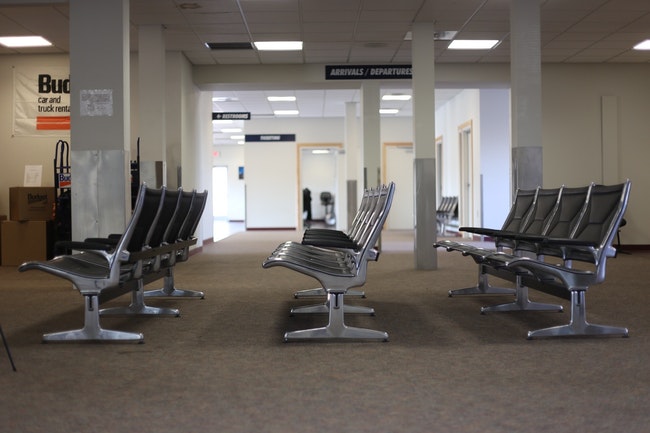Salem City Councilor Chris Hoy wanted one message clear to city staff at a work session last week — the council is largely committed to bringing passenger flights back to Salem’s airport.
But a path for doing so remains unclear after airport manager John Paskell presented a report to councilors outlining the millions the city needs to spend to get the airport ready for commercial flights.
Councilors generally agreed they wanted to see commercial air service in Salem, but asked city staff to get more specific about the costs of the idea and what it would take to fill the funding gap. Councilor Tom Andersen was particularly critical of the estimates laid out in the report, expressing concerns about the lack of detail on how such service would improve the local economy or reduce carbon emissions as advertised.
Salem hasn’t offered passenger flights since Delta left Salem in late 2008, 17 months after beginning commercial service. City councilors, airport officials and residents championing the effort to revive commercial air service at the airport say it would be a huge boost to Salem’s economy, drawing tourists to nearby wine country.
Interim City Manager Kristin Retherford revealed at the work session that one commercial airline, Aha!, has provided a letter to the Transportation Security Administration expressing interest in serving Salem with planes of roughly 50 seats. Paskell said the airline has discussed providing two flights per week from Salem to Reno, Nevada.
Paskell told Salem Reporter that two other airlines with planes seating up to 189 people have expressed interest without putting it in writing. He declined to name them.
All three had interest in starting potentially between now and next summer, he said.
But a TSA assessment in April found the Salem Municipal Airport could no longer accommodate the equipment and security screening used by the federal agency.
The airport’s needs include one-time costs such as renovating the terminal to accommodate more passengers, and buying equipment including a passenger board ramp and luggage cart to service planes, according to the council agenda item.
“The airlines want us to be ready in the spring because that’s when they want to be here, but on the other hand, the reality is even if we had the money today, we couldn’t be ready by spring,” Paskell said, “because we only recently found out what it was going to take to accommodate these larger aircrafts.”
Since 2017, a contingent of local business owners and residents called Fly Salem have sought to restore airline service Salem. They recently worked with the city to apply for a federal grant to offer airlines a minimum revenue guarantee, and the city is still waiting to hear back.
Brent DeHart, chair of the Fly Salem Steering Committee and president of Salem Aviation Fueling, said the report by city staff that the terminal isn’t ready for TSA screening or passengers is the biggest challenge for restoring commercial air service.
“The airport manager has been telling Fly Salem and the airlines that the airport terminal was ready for four years. So, this is an unwelcome and unpleasant surprise, to be told that we’re millions of dollars and possibly two years away from being ready to receive flights,” DeHart said.
DeHart said he thinks the impact of bringing back passenger flights on Salem’s economy would be “immeasurable in all aspects of life.”
“We’re going to spend less time on the road, we’re going to save time, we’re going to have better quality of life, we’re going to have economic development,” he said. “We’re going to have businesses flourishing in not just the conferences and hotels and restaurants, but the wineries, the ag sector.”
In 2019, the greater Salem area generated about 1.2 million air trips per year, or 1,586 passengers per day, according to the application. Most fly out of Portland.
To be successful, air service out of Salem would need to capture just 6% of that demand, according to the city’s application for the federal grant.
City staff in the report estimated a terminal renovation for a small passenger plane would cost about $3.9 million, with construction taking around nine months to a year, the report said.
To accommodate larger planes carrying 100 or more, a terminal renovation and expansion would cost between $10 million and $12 million, and design and construction would take between a year and 18 months, Retherford said.
Commercial flights would also require police and fire presence at the airport as well as nearly doubling the airport’s current staff, according to the agenda item. Adding airport employees needed to support flights would cost an estimated $530,000 per year, and fire and police staffing another $358,000.
“I think probably part of the problem that we’re having right now is that we have these financials that are highly speculative, because they’re based on a lot of assumptions because we don’t know the answers yet,” Hoy said at the meeting.
Salem City Councilor Vanessa Nordyke said that the cost and revenue estimates presented to councilors “seem very vague.”
“If we want to make this pencil and support our business community support all of our community members who want to meet up with their family via this airline service, we want to grow our economy — I know I want to do that — we need staff to find some creative funding solutions, because otherwise this isn’t going to work without that,” she said at the meeting.
Councilor Tom Andersen described the estimates as being part of a “failed business plan.”
“It’s going to cost us $1.438 million per year and the maximum we’re going to get back right now is $400,000,” Andersen said at the meeting.
He also said the report didn’t clearly explain how commercial air service would increase tourism to the Salem area, boost economic development or reduce carbon emissions as listed.
Councilor Jackie Leung was absent.
The airport is city-owned but covers its operating costs through fees charged to those who use it and its operations don’t rely on money from the city’s general fund.
Staff estimated airport revenue would increase $80,000 to $150,000 per year for the first two years, and $250,000 to $400,000 after.
DeHart said he thinks those projections are low. “The information that council was given and how it was presented seemed to be more like a worst case scenario, rather than a fantastic opportunity,” he said.
He said he believes the city should pursue the minimum TSA standards and costs to get initial flights started and qualify for more federal funding to improve facilities.
But Paskell said $3.9 million is the bare minimum needed to accommodate a 50-seat plane. “We have to find an outside funding source to accommodate it because city council made it clear there’s no general fund money available,” he said.
Paskell also said the city has to prepare for the risk of airline carriers leaving after some period of time if business doesn’t go as they expected.
“Now the city is left having paid all for all the improvements and hired all the staff and took all the risks, and everybody else walks away with no risk,” he said. “We want to be very methodical and thoughtful in how we walk through this because we’re putting this city’s potentially at tremendous risk of a lot of expense for minimum guaranteed revenue.”
The city received a roughly $540,400 state grant to cover the cost of buying equipment required for commercial air service earlier this year. Airport commissioners said in July they supported continuing the effort to restore air service to Salem and supported the city looking for additional funding sources to help cover some of the costs.
Previous coverage
Salem’s plans for commercial air travel in coming year hinge on federal grant
With interest from low-cost airlines, optimism grows about commercial service at Salem Airport

Ardeshir Tabrizian has covered criminal justice and housing for Salem Reporter since September 2021. As an Oregon native, his award-winning watchdog journalism has traversed the state. He has done reporting for The Oregonian, Eugene Weekly and Malheur Enterprise.









